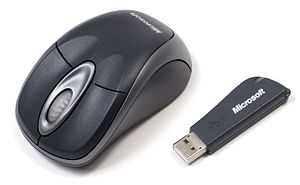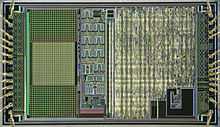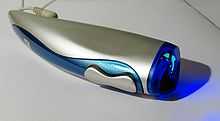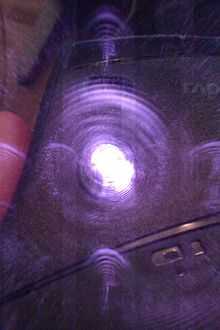Optical mouse

An optical computer mouse uses a light source, typically a light-emitting diode, and a light detector, such as an array of photodiodes or an image sensor, to detect movement relative to a surface. It is an alternative to the mechanical mouse, which uses moving parts to perform the same function.
The earliest optical mice detected movement on pre-printed mousepad surfaces, whereas the modern optical mouse works on most opaque surfaces; it is usually unable to detect movement on specular surfaces like glass, although some advanced models can function even on clear glass. Laser diodes are also used for better resolution and precision. Battery-powered wireless optical mice flash the LED intermittently to save power, and only glow steadily when movement is detected.
Early optical mice

Early optical mice, first demonstrated by two independent inventors in 1980, came in two different varieties:[1][2][3] Some, such as those invented by Steve Kirsch of MIT and Mouse Systems Corporation,[4][5] used an infrared LED and a four-quadrant infrared sensor to detect grid lines printed with infrared absorbing ink on a special metallic surface. Predictive algorithms in the CPU of the mouse calculated the speed and direction over the grid.

Others, invented by Richard F. Lyon and sold by Xerox, used a 16-pixel visible-light image sensor with integrated motion detection on the same chip[6][7] and tracked the motion of light dots in a dark field of a printed paper or similar mouse pad.[8] These two mouse types had very different behaviors, as the Kirsch mouse used an x-y coordinate system embedded in the pad, and would not work correctly when the pad was rotated, while the Lyon mouse used the x-y coordinate system of the mouse body, as mechanical mice do.
Modern optical mice

Modern surface-independent optical mice work by using an optoelectronic sensor (essentially, a tiny low-resolution video camera) to take successive images of the surface on which the mouse operates. As computing power grew cheaper, it became possible to embed more powerful special-purpose image-processing chips in the mouse itself. This advance enabled the mouse to detect relative motion on a wide variety of surfaces, translating the movement of the mouse into the movement of the cursor and eliminating the need for a special mouse-pad.
The first modern optical computer mice were the Microsoft IntelliMouse with IntelliEye and IntelliMouse Explorer, introduced in 1999 using technology developed by Hewlett-Packard.[9] It worked on almost any surface, and represented a welcome improvement over mechanical mice, which would pick up dirt, track capriciously, invite rough handling, and need to be taken apart and cleaned frequently. Other manufacturers soon followed Microsoft’s lead using components manufactured by the HP spin-off Agilent Technologies, and over the next several years mechanical mice became obsolete.
The technology underlying the modern optical computer mouse is known as digital image correlation, a technology pioneered by the defense industry for tracking military targets. A simple binary-image version of digital image correlation was used in the 1980 Lyon optical mouse. Optical mice use image sensors to image naturally occurring texture in materials such as wood, cloth, mouse pads and Formica. These surfaces, when lit at a grazing angle by a light emitting diode, cast distinct shadows that resemble a hilly terrain lit at sunset. Images of these surfaces are captured in continuous succession and compared with each other to determine how far the mouse has moved.
To understand how optical mice work, imagine two photographs of the same object except slightly offset from each other. Place both photographs on a light table to make them transparent, and slide one across the other until their images line up. The amount that the edges of one photograph overhang the other represents the offset between the images, and in the case of an optical computer mouse the distance it has moved.
Optical mice capture one thousand successive images or more per second. Depending on how fast the mouse is moving, each image will be offset from the previous one by a fraction of a pixel or as many as several pixels. Optical mice mathematically process these images using cross correlation to calculate how much each successive image is offset from the previous one.
An optical mouse might use an image sensor having an 18 × 18 pixel array of monochromatic pixels. Its sensor would normally share the same ASIC as that used for storing and processing the images. One refinement would be accelerating the correlation process by using information from previous motions, and another refinement would be preventing deadbands when moving slowly by adding interpolation or frame-skipping.
The development of the modern optical mouse at HP was supported by a succession of related projects during the 1990s at its central research laboratory. In 1992 John Ertel, William Holland, Kent Vincent, Rueiming Jamp and Richard Baldwin were awarded US Patent 5,149,980 for measuring paper advance in a printer by correlating images of paper fibers. In 1998 Travis N. Blalock, Richard A. Baumgartner, Thomas Hornak, Mark T. Smith, and Barclay J. Tullis were awarded US Patent 5,729,008 for tracking motion in a hand-held scanner by correlating images of paper fibers and document features, a technology commercialized in 1998 with the HP 920 Capshare handheld scanner. In 2002 Geoffrey Lee was awarded US Patent 6,392,632 titled "Optical mouse having an integrated camera." In 2002, Gary Gordon, Derek Knee, Rajeev Badyal and Jason Hartlove were awarded US Patent 6,433,780 for an optical computer mouse using image correlation.
LED mice

Optical mice often use light-emitting diodes (LEDs) for illumination. The color of the optical mouse's LEDs can vary, but red is most common, as red diodes are inexpensive and silicon photodetectors are very sensitive to red light.[10] Other colors are sometimes used, such as the blue LED of the V-Mouse VM-101 illustrated at right.
Laser mice

The laser mouse uses an infrared laser diode instead of an LED to illuminate the surface beneath their sensor. As early as 1998, Sun Microsystems provided a laser mouse with their Sun SPARCstation servers and workstations.[11] However, laser mice did not enter the mainstream market until 2004, when Paul Machin at Logitech, in partnership with Avago Technologies (formerly part of Agilent Technologies), introduced its MX 1000 laser mouse.[12] This mouse uses a small infrared laser instead of an LED and has significantly increased the resolution of the image taken by the mouse. The laser illumination enables superior surface tracking compared to LED-illuminated optical mice.
Glass laser (or glaser) mice have the same capability of a laser mouse but can also be used on top of mirror or transparent glass with few problems.[13][14] In 2008, Avago introduced laser navigation sensors whose emitter was integrated into the IC using VCSEL technology. [15]
In August 2009, Logitech introduced mice with two lasers, to track on glass and glossy surfaces better; they dubbed them "Darkfield" laser sensor.[16]
Power
Manufacturers often engineer their optical mice—especially battery-powered wireless models—to save power when possible. To do this, the mouse dims or blinks the laser or LED when in standby mode (each mouse has a different standby time). A typical implementation (by Logitech) has four power states, where the sensor is pulsed at different rates per second:
- 11500: full on, for accurate response while moving, illumination appears bright.
- 1100: fallback active condition while not moving, illumination appears dull.
- 110: standby
- 12: sleep state
Movement can be detected in any of these states; some mice turn the sensor fully off in the sleep state, requiring a button click to wake.[17]
Optical mice utilizing infrared elements (LEDs or lasers) offer substantial increases in battery life. Some mice, such as the Logitech V450 848 nm laser mouse, are capable of functioning on two AA batteries for a full year, due to the low power requirements of the infrared laser.
Mice designed for use where low latency and high responsiveness are important, such as in playing video games, may omit power-saving features to improve performance.[18]
Optical versus mechanical mice

Unlike mechanical mice, which can become clogged with lint, optical mice have no moving parts (besides buttons and scroll wheels); therefore, they do not require maintenance other than removing debris that might collect under the light emitter. However, they generally cannot track on glossy and transparent surfaces, including some mouse-pads, sometimes causing the cursor to drift unpredictably during operation. Mice with less image-processing power also have problems tracking fast movement, whereas some high-quality mice can track faster than 2 m/s (7km/h).
Some models of laser mouse can track on glossy and transparent surfaces, and have a much higher sensitivity.
As of 2006 mechanical mice had lower average power requirements than their optical counterparts; the power used by mice is relatively small, and only an important consideration when the power is derived from batteries, with their limited capacity.
Optical models outperform mechanical mice on uneven, slick, soft, sticky, or loose surfaces, and generally in mobile situations lacking mouse pads. Because optical mice render movement based on an image which the LED (or infrared diode) illuminates, use with multicolored mouse pads may result in unreliable performance; however, laser mice do not suffer these problems and will track on such surfaces.
References
- ↑ John Markoff (May 10, 1982). "Computer mice are scurrying out of R&D labs". InfoWorld 4 (18): 10–11. ISSN 0199-6649.
- ↑ John Markoff (February 21, 1983). "In Focus: The Mouse that Rolled". InfoWorld (InfoWorld Media Group, Inc.) 5 (8): 28. ISSN 0199-6649.
- ↑ Sol Sherr (1988). Input Devices. Academic Press. ISBN 0126399700.
- ↑ Liz Karagianis (Fall 1997). "Steve Kirsch". MIT Spectrum.
- ↑ Retrieved 31 December 2006 "Portraits of MIT-Related Companies: Infoseek, Santa Clara, CA". MIT: The Impact of Innovation. MIT.
- ↑ Richard F. Lyon (1981). "The Optical Mouse, and an Architectural Methodology for Smart Digital Sensors". In H. T. Kung, Robert F. Sproull, and Guy L. Steele. VLSI Systems and Computations. Computer Science Press.
- ↑ Stan Augarten (1983). State of the Art: A Photographic History of the Integrated Circuit. Ticknor & Fields. pp. 60–61. ISBN 0-89919-195-9.
- ↑ "Retrieved 31 December 2006". Digibarn.com. Retrieved 2010-05-29.
- ↑ "Microsoft Press Release, April 19th 1999". Microsoft. 1999-04-19. Retrieved 2011-05-11.
- ↑ Winn L. Rosch (2003). Winn L. Rosch hardware bible (6th ed.). Que Publishing. p. 756. ISBN 978-0-7897-2859-3.
- ↑ Computer Engineering Tips – Mouse. Retrieved 31 December 2006.
- ↑ Logitech – MX1000 Laser Cordless Mouse
- ↑ Comparison of optical, laser, and glass laser mouse.
- ↑ Glass laser mouse by A4Tech.
- ↑ "Avago Technologies Announces Miniature Laser Navigation Sensors for Mouse Applications". January 28, 2008. Retrieved 2013-03-25.
- ↑ "Logitech Darkfield Innovation Brief". Logitech. 2009.
- ↑ Certain models of Targus mice work this way.
- ↑ Examples of mice which sacrifice power-saving in favour of performance are the Logitech G5 and the Razer Copperhead
| ||||||||||||||||||||||